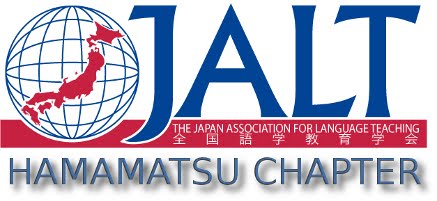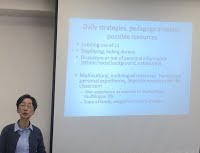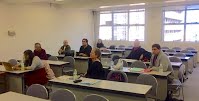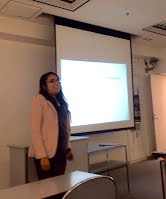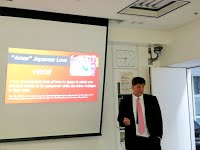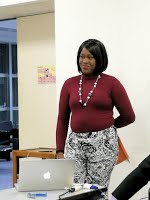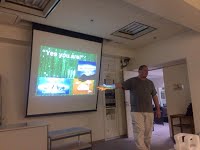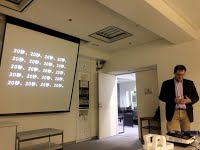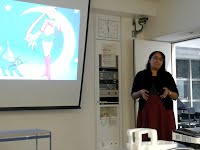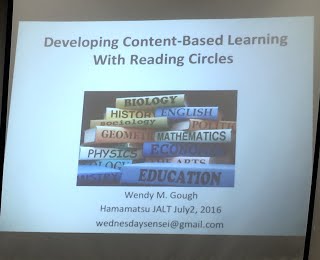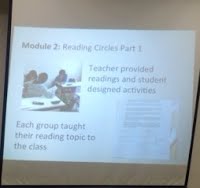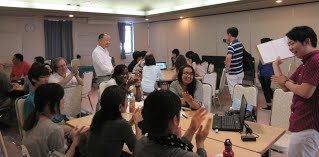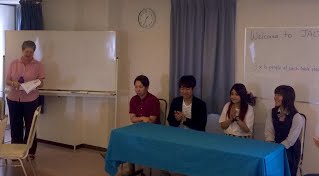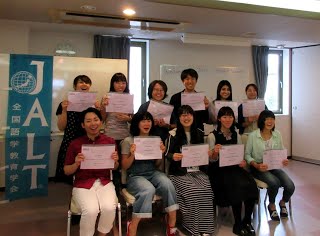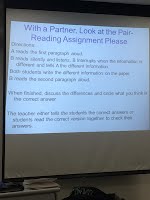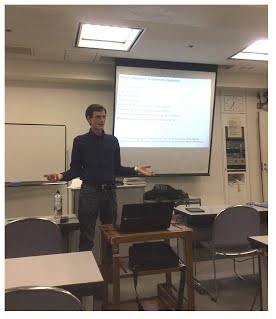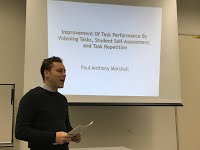2016 Meeting Minutes
February 19, 2017 Hidden Stories about Race in Japan: Confronting Native-Speakerism and Nihonjinron in University English Education -- Prof. Laura Kusaka
In her presentation (the final one for the Hamamatsu chapter of JALT), Professor Kusaka presented select examples from stories co-constructed with her in interviews conducted over a period of three years with five other Japanese-American university teachers positioned by dominant discourses in which native speaker (NS) is a code word for White (Kubota & Fujimoto, 2013). In addition, how tenets of nihonjinron (Befu, 2001) impact them as TESOL professionals was explored. We noticed a definite evolution in how the teachers came to view themselves in Japan, but a lot less so in terms of how society regarded them. For example, there were some familiar refrains. When "Sarah" couldn't speak Japanese, some were shocked. “Why don’t you speak Japanese? It’s in your blood,” said one otherwise educated Japanese man. In the case of "Teresa, " she refused to use any Japanese (target language only) in the classroom in spite of her (basic) knowledge of Japanese. She explained in detail who she was and where she came from because students were not satisfied with her “I’m American” and that’s it. Some students could not and would not believe she wasn't Japanese. Later, as she evolved and became more comfortable, she became content referring to herself as Teresa from the USA. All in all, in a very easy give and take style, Prof. Kusaka reinforced that discourse can be (and is) limited by various societal constraints. |
January 15, 2017 Bridging the Gap: Japanese High School Education & Teaching English as an ALT --Farrah Hasnain
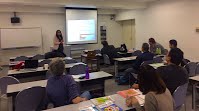 In her presenta tion, Farrah Hasnain (a 3rd year ALT from Washington, D.C.) e xplained to us from an ALT's perspective how English is currently being taught in public and private high schools throughout Japan. She started off with some basic history of English education in Japan and then provided a comprehensive summary of the JET Program since its inception in 1987. In the second part of her presentation she focused on the challenges and opportunities for ALTs teaching in various schools throughout Japan as well as providing an accurate description of the state of English teaching in high schools. For example, in some schools ALTs are able to take control of lessons; the so-called grammar-translation method is no longer alive and well; and in spite of MEXT's written guidelines (policy) for teachers to be mainly using English in the classroom, this is (she stated) not the case, especially when it comes to entrance exam preparation. |
December 10, 2016 Hamamatsu Annual "My Share"
October 8, 2016 Diane Nagatomo, Teaching English in Japan: Understanding Identity Development Through Teachers’ Stories.
As usual, Prof. Diane Nagatomo gave a lively and down-to-earth presentation about what is in fact a somewhat complex theme. She described the results of her recent study that investigated the personal and professional identity development o female English teachers in Japan who have chosen to reside here as permanent migrants. Most came to Japan out of a desire for temporary overseas adventure, but some decided to make Japan their permanent home and English language teaching their career. In particular, her research focused on foreign women who are married to Japanese men. She invited us to look at her recent research (book) which examines this in detail. She described in some detail the intricacies and negotiations (and sometimes refusal to negotiate) of a particular American woman who went from rural English teacher to rural, but very accomplished priest who also continued to teach English sometimes on the same day that she was presiding over funeral rituals. |
July 2, 2016: Wendy M. Gough "Developing Content-Based Learning With Reading Circles"
In the Reading Circles that she has successfully implemented in her course, students self-selected topics that they would teach to other groups. In order to find the correct level for the group, Gough had the students evaluate the difficulty level of various graded readers. Once consensus was reached, students had to find suitable articles at the agreed upon level. In a group, all students read the same articles. Each student was later responsible for assuming a certain role: comprehension check, vocabulary testing, discussion leader, making activities. In effect, the teacher's workload is reduced as students become responsible for their own tasks. It is roughly equivalent to students making and examining a unit in a reading textbook. Interestingly, Gough reported, students enjoyed coming up with devilishly difficult questions in order to try to stump their classmates. In spite of the brief discussion of ER above, the reading done by students was intensive reading. But before letting students be responsible for their own learning, Gough led the first module so that students would have a solid idea as to how to proceed. However, students still selected the topics that they wanted to study. This module lasted for a number of weeks. Gough reported that students were satisfied with the course and felt that indeed they had improved in the areas specified at the outset of the course. The presentation showed that from start to finish, the course was laid out in a clear, logical fashion. |
Student Voices Seminar in Kakegawa -- June 12, 11a.m. - 5p.m.
The Shizuoka and Hamamatsu chapters cooperated to hold Student Voices, an event was designed to showcase the learning experiences of students. It was well-attended and overall turned out to be even better than the organisers had anticipated. |
Adam Jenkins Saturday, May 28 Escaping the Matrix: Using CALL and e-Learning Responsibly
Adam Jenkins from Shizuoka Institute of Science and Technology introduced a plethora of ways that Moodle technology, (including the Moodle online Reader created by Tom Robb) can facilitate learning. He made a point of referring to this as learning and not e-learning, suggesting that for many of our students there is little distinction between e-learning and learning. It is a point well taken since resistance to e-learning comes from boards of education, teachers and university instructors, not students. He showed how to use numerous Moodle features including online tests, online instant messaging, multimedia applications, and data analysis. He mentioned that it is possible to upload a lot of files as homework in order to use the classroom for different learning tasks. The presentation took an unexpected turn when there was passionate discussion among those who value reading as something much more than a measure of ER language achievement. Some participants challenged the value and necessity of Moodle Reader and its testing format. |
Greg Goodmacher "Creating and Adapting Teaching Materials" April 16
Creating and Adapting Teaching Materials, April 16, 2016 Greg Goodmacher, Keiwa College professor (Niigata) & freelance writer
Greg Goodmacher enjoys writing and sharing materials. The co-author of a number of textbooks, he led an attentive audience through a series of discussions and activities related to the various aspects of teaching materials, and how best to adapt them for optimum classroom use. Some areas to consider when adapting materials are personalisation, localisation, modernisation, adding choice, catering for various learner styles, providing more learner autonomy, encouraging higher level cognitive skills, and making language input more engaging, among other elements. Memory tasks were also focussed upon. The presentation concluded with teachers assisting other teachers in their endeavours to make textbooks more relevant and accessible to all stakeholders. Reported by Susan Laura Sullivan. |
March 13 Daichi Tanabe: "Acquiring English in Japan is a lifetime journey: Ways to keep students motivated"
Daichi Tanabe calls himself a typical hardworking high school teacher who teaches 17 hours a week (this writer wonders how typical he is). According to him, what motivates students are tests, university entrance exams, movies, pop music, and study abroad. He introduced his classes and some of what he does in them. He surveyed his 1st & 2nd year students. Do you like to study English? 70% Do you like using English? 70% Do you want to use it? 80% Do you think you will be able to use it fluently? 42% Is there a great need for English 66% Do you want to English speaking countries? 69% Do you have any opportunities to use English outside of class? 19% (some) 4% (yes) Do you enjoy English class? 79% Do you study English besides homework? 9% and 23% Tanabe considers these results to be modestly all right. From this writer’s perspective, these are rather good percentages. Many other classes would have less favourable views about studying and learning English. CLASS ACTIVITIES Physical letter writing, not e-mail — his students were happy to write a letter to his friend and receive a physical letter. Songs — he introduces songs and sings songs in class — one song per month English Name Project — He gave everyone an opportunity to choose an English name. That is, they chose their own name. This improved their motivation to seem English and use it. Students liked calling each other by their English names. Video Chat Project — In just a few seconds, students realised the value of listening and speaking English because they had an opportunity to communicate for real with someone of similar age. Classmates helped in negotiating meaning so that the speaker could communicate her meaning. A cultural question: a student wanted to know why a guy was wearing a cap at home, but didn’t have the ability to do that. Frustration turned into motivation. Students understood that their textbooks do not give them the language for communication. Murder Mystery Activity (C-B. approach, groups) Excellent group activity and the level can be set up or down. You can modify the language in order to emphasise specify grammar. All in all, the many activities that he has done in class have a lot to do with his small class size, but other teachers could certainly try them, adjusting the level and content for the particular needs of their students. |
"Improvement of Task Performance by Videoing Tasks, Student Self-Assessment, and Task Repetition," January 25, 2016. Anthony Marshall (Shizuoka University of Art and Culture)
Drawing on experience training workers on an Australian-run, Chinese-owned mine in Laos, Anthony Marshall broke down his methods and research in using video and task repetition as effective tools for improving language performance. Laotian workers, including teachers, miners, security guards and managers, were required to take intensive English lessons with the ultimate goal of transforming the mine into a Laotian-run endeavour. The workplace infrastructure and mining expertise were Australian-based, so initially knowledge and use of English was paramount.
Even though many workers were not well-versed in the linguistic intricacies of their own language, it was expected some would ultimately receive instruction and instruct others on safety and practical measures around the worksite. The original language of instruction was English, therefore rapid acquisition of the same was expedient. Anthony and his students concentrated on the discourse elements of stress, repetition, pausing and stretching key words for emphasis within presentations. Students recorded and viewed their presentation, looking for these elements, conducted student self-assessment, and repeated the task. Using this deliberate form of noticing, improvement in language use in this setting was noted. The method is transferable to Japanese and other language students wishing to improve specifics of performance and communicative competence within presentations. Noticing and repetition can be beneficial in many language learning areas.
Anthony’s teaching experience was unique amongst the audience members, and his explanation and real life experience reflected the importance of effective English acquisition and use within the global community.
Reported by Susan Laura Sullivan |
